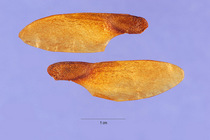
Permission: Some rights reserved
Cigar-box wood
Cedro is a tree of the New World tropics, appearing in forests of moist and seasonally dry Subtropical or Tropical life zones from latitude 26°N. on the Pacific coast of Mexico, throughout Central America and the Caribbean, to the lowlands and foothills of most of South America up to 1200 m altitude, finding its southern limit at about latitude 28°S. in Argentina. Cedro is always found naturally on well-drained soils, often but not exclusively on limestone; it tolerates a long dry season but does not flourish in areas of rainfall greater than about 3000 mm or on sites with heavy or waterlogged soils. Individual trees are generally scattered in mixed semi-evergreen or semi-deciduous forests dominated by other species. Mahogany, a close relative, is often found with cedro and both suffer damage from the same pest, the mahogany shootborer .Cedrela odorata is the most common species in the genus, widespread in seasonally dry tropical and subtropical forests; it is deciduous in the dry season which may last several months. C. lilloi and C. montana occur at higher altitudes in moister conditions, and are evergreen or only briefly deciduous. These additional names have been published, but are not now accepted as distinct taxa (see Pennington & Styles 1981): C. angustifolia, C. balansae, C. barbata, C. boliviana, C. brunelliodes, C. ciliolata, C. More
* Media related to Cedrela odorata at Wikimedia Commons * List of honey plants * List of plants of Atlantic Forest vegetation of Brazil External links - * Cedrela odorata at the IUCN * Retrieved from "http://en.wikipedia. More
Unknown Garden location Unknown Garden notes Cedrela odorata has wood that is strongly resinous. More
Illegal logging of Cedrela odorata in Peru. More
